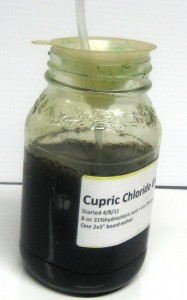I had to do the last 4 IR boards for the Educubes last night, and hoped the CuCl2 etchant might be ready. It wasn’t – so I used ammonium persulfate again.
Most of the 80g of wire dissolved over the course of a couple days with the bubbler running. But the solution changed from clear very dark green to milky green, with a layer of brown at the bottom. (Sorry, no pic.) The Adam Seychell page indicated that this is probably cuprous chloride precipitating out of the solution. Since the comment was that such precipitation occurs with dilute solutions, I tried adding acid. I added about 130 ml of the commercial 31% HCl, and the solution immediately became clear (well, not cloudy) again.
There was still some of the wire at the bottom of the jar, so I left it bubbling. But even after several hours, the “drop on a white surface test” showed 10+ g/l of Cu+1. I don’t know whether I’m just still not at equilibrium – more copper coming into solution from the wire that the bubbler hasn’t been able to keep up with by oxidizing to Cu+2 yet – or I’m stuck for some other reason. I’ll let it run and see what happens.
I have mixed feelings about adding acid. It obviously increases acid concentration – which is probably good. But it decreases the copper concentration – which in my case is bad. My acid is just about 10M (from a chart in the Seychell page). His graph of etch rate v HCl concentration goes from well less than 1M to 4M. So maybe adding acid would make the concentration inappropriately high. Rats – I really didn’t want this to turn into a chemistry project.
A little later: The wire is all gone, but the solution is much more brown than green (see funnel pic below). In a test tube I tried adding acid and separately, adding water. Both gave a clear green solution. I guess I need to resurrect enough chemistry to do what probably amounts to a high school chemistry homework assignment. But at least I kept notes what what all has gone into that jar, so I can make a fair quantitative assessment.
An interesting possible two-birds-with-one-stone came up with the 1M NaOH titrant Seychell suggests using in a titration test of the etchant. I use NaOH as positive developer in my PCB making process. It’s cheap to make and doesn’t take much to develop a board, so I make a bunch and throw out the small amount I use each time. Do you suppose the concentrations of the developer and the titrant might be the same so I could just stock one solution? <checks out developer recipe> Nope. He wants 1M, and my developer is 0.25M. Yeah, I could stock 1M and dilute it 3:1 with water for developer, but that’s a bit of a hassle. I happen to just be out of developer, so maybe I’ll make up just enough 1M so when diluted it will refill my developer bottle. I’ll use a little for the dumb titration I’m probably going to have to do, and hope to not have to do that again.
On the mechanical side, the half-full quart jar of wanna-be etchant with wire and the bubbler looked awful after a couple of days of running with no top on the jar. To my surprise, there was a thick crust of light green crud on the outside of the jar, and the bubbler hose was wet with spray. (Sorry again – no pic.) If I’m going to need to bubble this stuff frequently, I need a better way to manage the spray/splashing.
I think a plastic funnel will do the trick. It just fits over the bubbler tube, provides a loose cover, and whatever collects on it a) is contained within the jar, and b) basically dribbles back into the jar.
I’m sure there will be more…

